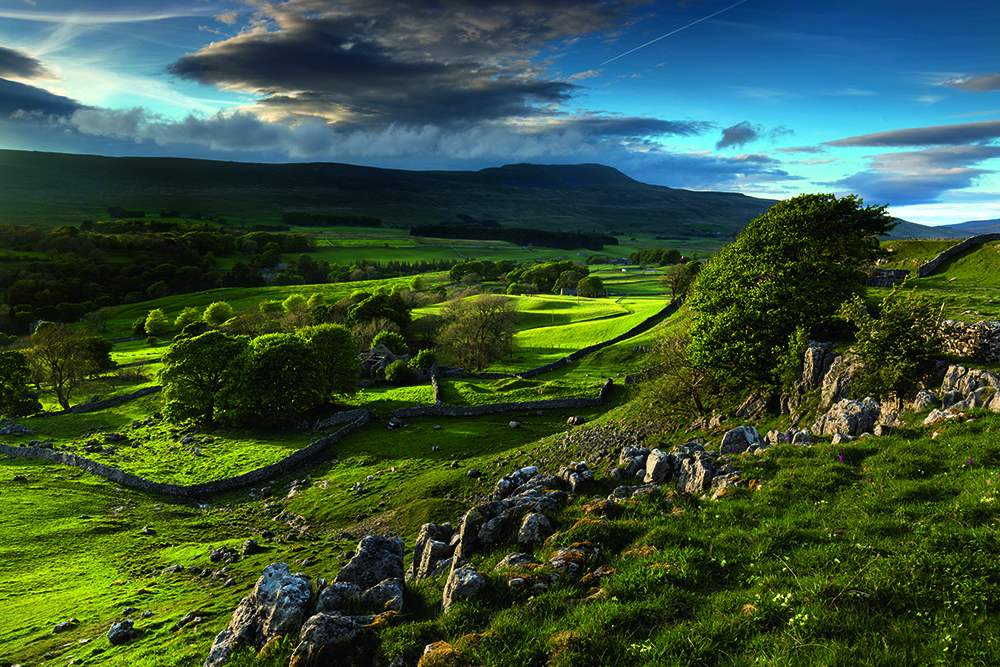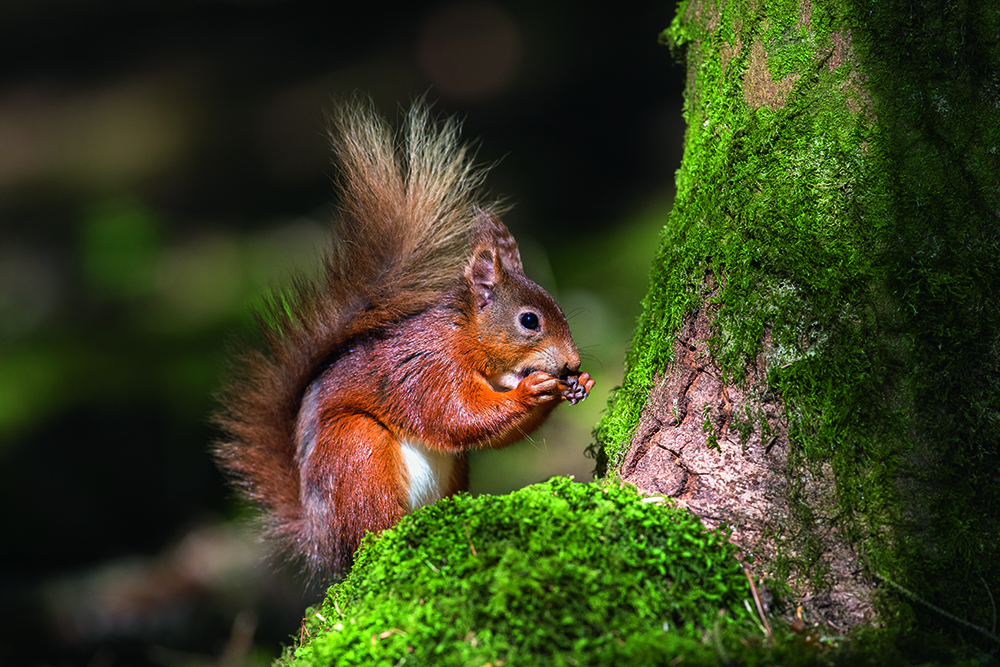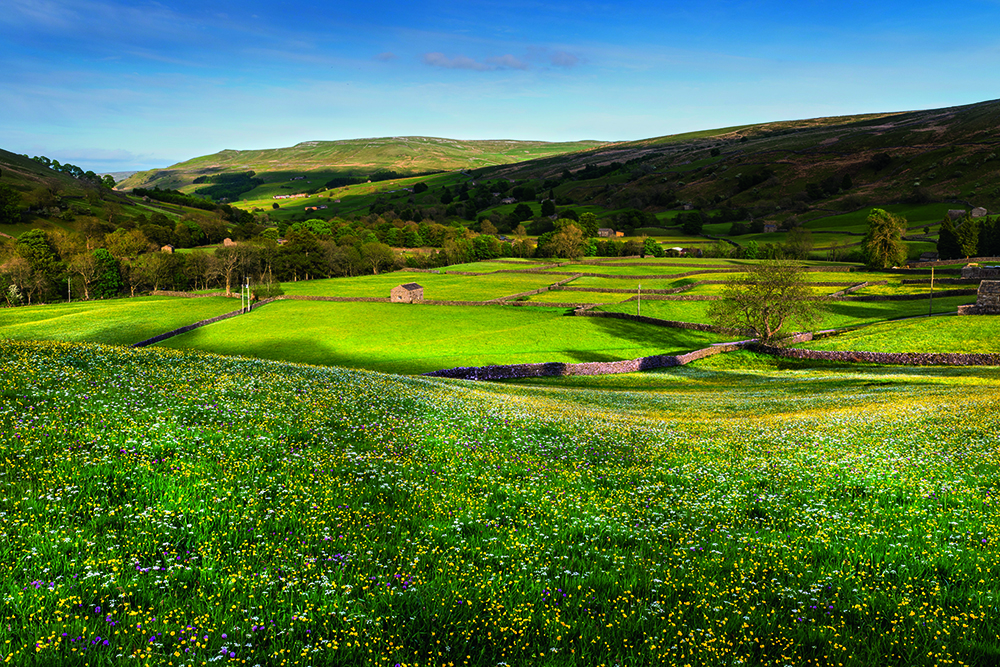Motorhome travel: Wildlife spotting in the Yorkshire Dales

In what was becoming an epic tour of the northwest of England in search of its wildlife highlights, we skipped across the M6 to explore the Yorkshire Dales National Park. We started at Ingleton – and any self-respecting walker visiting Ingleton has to climb Ingleborough. We caught the bus to Clapham so that we could climb Ingleborough from one side and come back down the other.
Our first glimpse of wildlife
Around Clapham we enjoyed a grey wagtail on the stream; in the rushy pastures there were brown hares and, flying back and forth to the woods, was a mistle thrush carrying piles of hay for a nest. As we passed Ingleborough Caves we entered a classic dry valley. At the edge of the tree line, near the incredible gorge at Trow Gill, we watched two male redstarts, a willow warbler and a blackcap singing. Above the gorge the ground levels out for a short spell and here we saw a green hairstreak butterfly. The birds at this altitude were mostly meadow pipits and skylarks.
A little further and we had left the limestone behind. As we passed the famous sinkhole of Gaping Gill we were on gritstone with its associated boggy landscape. Here we listened in awe to the sound of a curlew and a snipe ‘drumming’, a sound which the bird makes by vibrating its tail feathers.
As we climbed higher the terrain became rockier. We saw several male wheatears singing to proclaim their seemingly barren territory and a buzzard drifted overhead. We were glad to be staying at Stacksteads; this lovely site has a private leisure centre with large windows giving views of Ingleborough, so we relaxed in the whirlpool bath, sauna and pool looking at the mountain we’d just conquered.
Yorkshire's nature reserves
On leaving Ingleton we took the road to Hawes, stopping for a look around the two National Nature Reserves at Southerscales and Ribblehead Quarry. Of the two it is the first, partway up Ingleborough, which offers the better views and an immense limestone pavement with such character as I have never seen before. The clints are separated by deep, craggy grikes, some of which have early purple orchids, ferns or even trees growing out of them. The least common flower, to me, was hairy rockcress.
Ribblehead Quarry is less beautiful, but arguably more productive for flowers and wildlife. There’s parking on the opposite side of the railway line to Ribblehead Station. In the quarry we saw two pairs of breeding lapwing and one pair of ringed plovers. Also here are good colonies of bird’s-eye primrose and, on the limestone pavement, we found mossy saxifrage growing around the ancient settlements.
In Hawes we stayed at Bainbridge Ings Caravan and Campsite, set in an area of buttercup meadows and barns with footpaths leading to Burtersett and Hawes. The barns are a special feature of the Dales and they have been around long enough to be adopted by a lot of wildlife. Birds such as swallows, house martins, stock doves, wheatears and house sparrows commonly use them for nesting.
Searching for red squirrels in Yorkshire
Wensleydale is famous for one very well-known dairy product generously promoted by Wallace and Gromit, but the main reason for us staying in Hawes wasn’t to eat cheese, I wanted to see red squirrels. In terms of mainland England this is very much the frontline between the red and grey squirrels and we are lucky that one couple, Hugh and Jane Kemp, made their home in Mirk Pot Farm in Snaizeholme, near Hawes, about 40 years ago.
They grew coniferous trees, which eventually attracted red squirrels. They cared for the squirrels and, in time, they created a wonderful trail through their land for people to enjoy these endearing creatures. I don’t like to have high expectations when it comes to wildlife but, as soon as we arrived, we saw a red squirrel in the garden of Mirk Pot. As we walked onto the 2½ mile trail, we were effectively mobbed by them! As well as the squirrels, we also saw cuckoo, curlew, stock dove, siskin and a lovely spotted flycatcher in a clearing.
Woodland in the Yorkshire Dales
Woodland is a rare commodity in the Dales, occupying only 1.5% of the land. We walked beside the River Ure and up to Shaw Gill Wood. Those bits of native deciduous woodland that do survive are really attractive in the spring, with wild garlic growing in profusion beside the stream in the wood.
Having had a long and dry spell, the water level in the Ure was low. This exposed large pebble beaches on the inside of each meander where we saw dipper, grey and pied wagtail, common sandpiper and ringed plover. The low sandy banks on the outside of each meander had dozens of holes from sand martins, which continually flew low over the river looking for insects.
From Wensleydale we took the short journey north to Swaledale, stopping at Buttertubs on the way. Buttertubs is a selection of large and peculiarly shaped sinkholes in the limestone. Whilst we were there it was calm and I could hear birds calling from all around. The first I picked out was a golden plover, its plaintive ‘kew’ calls coming from Long Scar to the east. Red grouse shouted ‘go-back, go-back’ as if annoyed by something and curlews did their magical thing. More interesting was a blackbird-type song from the area above Buttertubs; this was a ring ouzel, sometimes known as a mountain blackbird.
Exploring stunning Swaledale
We continued to our next site at Usha Gap Camping and Caravan Park, near Muker, a village renowned for its upland hay meadows, which are rich in wildflowers and form a Site of Special Scientific Interest (SSSI). Many of the fields have the characteristic stone-slab footpaths leading through them, allowing visitors easy access.
In comparison to Wensleydale, Swaledale is narrower with a more upland feel. Photographically, Swaledale is a tremendous place with beautiful contours and wonderfully sinuous dry stone walls. It has even more iconic barns than Wensleydale. From Usha Gap we drove down Swaledale to stay near Reeth, a really attractive market village arranged around a green with plenty of pubs and tearooms.
Our site at Nun Cote Nook (a few miles east of Reeth) offered good access onto Fremington Edge, where we spent a day walking. Walking through the heather in early June was entertaining. Red grouse had their young and they were still in groups, but impossible to see. Every now and then we would disturb a family. The young would explode into the air, flying short distances – all they were capable of – in every direction. Also on the heather we saw lots of golden plovers and, though I had expected to see ring ouzels on the scree of Fremington Edge, expectation led to disappointment.
On to Cumbria...
After the Yorkshire Dales we planned to visit Cumbria so, for our final stop, we headed back west up Swaledale to stay in Keld for a couple of nights at Rukin’s Park Lodge Camping Site. Several farms, including Park Lodge Farm on which Rukin’s Campsite is situated, are working to improve the habitat for black grouse in the area.
I always feel the telling question to ask after a visit is, ‘Would I go back again?’ The answer is, ‘Yes!’ I particularly enjoyed exploring the limestone countryside around Ingleborough and I thought Swaledale in early June was stunning. Unexpectedly coming across black grouse was amazing, but the one outstanding wildlife moment was being mobbed by red squirrels at Snaizeholme. It is rare moments like that which remind you why it’s important to cherish our wonderful wildlife.
The full feature was originally published in the July 2018 issue of MMM magazine. Want to read inspiring motorhome travel features every month? Subscribe to MMM magazine here.








.jpg)




Recent Updates
Engine management lights: all you need to know
What is the engine management light? What does it mean, and what do I have to do? ...
Motorhome air suspension: all you need to know
Motorhomes are heavy and the additional weight of equipment and height of the bodywork can increase the loads ...
Motorhome WiFi: how to get better motorhome internet
Staying connected on the move is more and more essential, so relying on campsite WiFi isn't an option – here ...
A class of their own - our guide to A-class motorhomes
Thinking of trading up to an A-class, or even going straight to the top of the motorhome tree? We guide you ...
Explore overseas on a motorhome dream tour
Enjoy exotic travel in a campervan or motorhome by hiring, swapping with someone else or exporting your ...
Motorhome water systems: everything you need to know
On-board water is an important part of every motorhome – here’s everything you need to know ...
Campervanning in Europe: what you need to know
Whether you're planning a leisurely drive through the French countryside, navigating bustling city streets in ...
Campervan security: all you need to know
With thefts on the increase, it’s important to know how to keep your campervan secure and prevent campervan ...
Campervan furniture: everything you need to know
Our campervan experts guide you through all the essentials for your campervan, including tables, chairs, ...
Campervan finance: how to fund your purchase
Here we look at the different types of campervan finance available, to help you decide what’s the best option ...
Other Articles
Britain’s best used motorhomes
Want a great motorhome without paying the premium for a new one? Here's a guide to the best you can get in the pre-owned market for each layout, ...
Which motorhome? Choosing the perfect motorhome for you
Choosing a motorhome or campervan is one of the biggest buying decisions you’ll ever make, so it's important ...
Campervan washroom essentials: stay fresh on the road
Our guide will take you through the campervan washroom essentials you'll need so you're well-prepared for ...
Dogs in campervans: all you need to know
Follow our advice and your dog will enjoy campervanning as much as you do ...
Electric campervans: all you need to know
Our guide will take you through everything you need to know about electric campervans and what the future ...
Motorhome electrics: a complete guide to your motorhome electrical set-up
Motorhome electrics can dramatically enhance the convenience and comfort of your vehicle – but they can be ...
Lighting for campervans: all you need to know
We guide you through all the lighting options available for you and your campervan, including interior ...
Electric bikes for motorhomes: our ultimate guide
Read our comprehensive guide to electric bikes for motorhome owners, helping you add electric power to your ...
Our guide to 'cheap' motorhomes in 2024
If you're on the hunt for an affordable new motorhome, this is the best place to start – we've rounded up a ...
Campervans in winter: all you need to know
Here's your guide to preparing your campervan for the colder months, whether you will be using it or putting ...